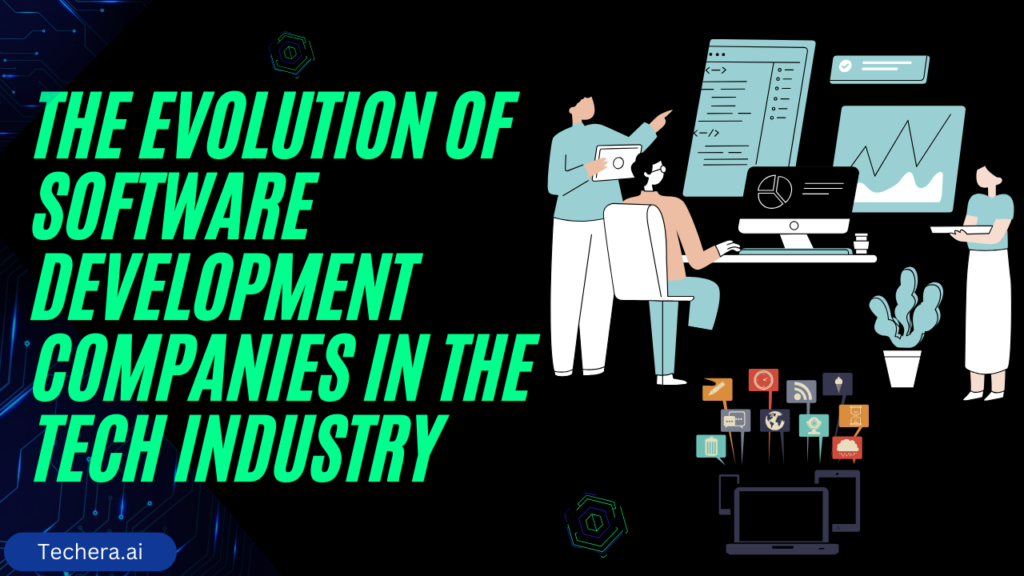
The Evolution of Software Development Company in the Tech Industry” explores the transformation of software development company over the years, highlighting key trends, technological advancements, and innovative practices that have shaped the industry. This blog post provides insights into how these companies adapt to changing market demands, embrace emerging technologies, and redefine their roles in the tech ecosystem
Introduction
The tech industry is one of the fastest-changing landscapes, and software development companies have been at its core. From the early days of mainframe programming to the modern era of cloud-based solutions and AI, these companies have evolved significantly. Let’s take a journey through time to understand how software development companies have shaped—and been shaped by—the tech industry.
The Early Days of Software Development
The 1960s and the Birth of Software Engineering
In the 1960s, software engineering wasn’t even a term. Software development was primarily done in-house by companies building systems for their specific needs. These early days were marked by large mainframe computers and basic programming languages like COBOL and Fortran.
Custom Software Development in the Early Years

Back then, software was tailored for specific tasks—think payroll processing or inventory management. Companies didn’t have the luxury of off-the-shelf solutions, making every project a unique challenge.
The Shift to Commercial Software
Rise of Software Products in the 1980s
The 1980s brought a shift toward commercially available software. Companies like Microsoft and Oracle began developing products that could be purchased and used by multiple organizations. This marked the beginning of software as a scalable business model.
Also Read:- Common Mistakes to Avoid When Hiring a Software Development Company
The Impact of Personal Computers on Software Demand
With the rise of personal computers, the need for software grew exponentially. Suddenly, software wasn’t just for businesses—it was for individuals, too. This shift expanded the market and created opportunities for more companies to enter the field.
Emergence of Outsourcing and Offshore Development
The 1990s Boom in Outsourcing
In the 1990s, companies started outsourcing software development to save costs. Countries like India and China became hubs for offshore development, offering skilled developers at a fraction of the cost.
Cost Savings and Globalization in Software Development

Globalization made it easier for companies to collaborate across borders. This period saw the rise of outsourcing giants who specialized in delivering projects for clients around the world.
The Dot-Com Era and Its Influence
Explosion of Web-Based Applications
The dot-com boom of the late 1990s and early 2000s changed everything. Companies rushed to create web-based applications, leading to a surge in demand for software developers.
Shaping the Modern Software Development Model
While the dot-com bubble burst, it left behind a more mature industry. This era solidified the need for scalable, user-focused software development practices.
Agile and the New Development Paradigm
Introduction of Agile Methodologies
Agile methodologies revolutionized how software was developed. Introduced in the early 2000s, Agile emphasized collaboration, flexibility, and iterative progress.
Benefits of Agile for Software Development Companies
Agile allowed companies to respond quickly to changes and deliver products faster. This method became standard practice in contemporary software development.
The Cloud Computing Revolution
SaaS (Software as a Service) and Its Growth
Cloud computing transformed software from a product to a service. SaaS companies like Salesforce and Dropbox led this change, making software more accessible and affordable.
The Role of Cloud Platforms in Modern Development
Platforms like AWS and Azure now form the backbone of many development projects, enabling scalability and reducing infrastructure costs.
AI and Machine Learning Integration
How AI is Changing Software Development
AI has opened new doors in software development. From automating testing to predicting user behavior, AI tools are becoming indispensable.
New Opportunities for Software Companies
AI isn’t just a tool—it’s a market. Companies are developing AI-driven products that are reshaping industries, from healthcare to finance.
Remote Work and Distributed Teams
COVID-19 and the Shift to Remote Development
The pandemic accelerated the trend toward remote work. Software development companies quickly adapted to this new reality, leveraging tools like Zoom and Slack.
Managing Distributed Teams Effectively
While remote work offers flexibility, it also requires robust management practices. Clear communication and collaboration tools have become essential.
Security Challenges in the Modern Era
Rising Cybersecurity Threats
As software becomes more integral to daily life, it also becomes a bigger target. Cybersecurity is now a top priority for every software company.
How Companies Are Addressing Security Risks
From adopting DevSecOps practices to using AI for threat detection, companies are finding innovative ways to stay secure.
The Future of Software Development Companies
Predicting Trends in Development Practices
The future is bright for software development. Trends like low-code platforms, blockchain, and edge computing are set to redefine the industry.
Expanding into Emerging Technologies
As new technologies emerge, companies will continue to innovate, creating solutions that we can’t even imagine today.
Conclusion
The development of software development company is a reflection of the wider shifts in the technology sector. From humble beginnings to global powerhouses, these companies have continually adapted to meet the needs of a changing world. As we look to the future, one thing is clear: software development will remain at the heart of technological innovation.
Frequently Asked Question
Q. How has cloud computing changed software development?
A. It has made software more scalable, accessible, and cost-effective by eliminating the need for physical infrastructure.
Q. Why is Agile so popular among software companies?
A. Agile offers flexibility, faster delivery, and better collaboration, making it ideal for dynamic projects.
Q. What part does AI play in the creation of software?
A. AI automates repetitive tasks, enhances user experiences, and helps in areas like testing and security.
Q. How do companies manage security risks in software?
A. By implementing DevSecOps, using AI-driven tools, and staying updated on the latest security threats.
Q. What are the key future trends in software development?
A. Low-code platforms, blockchain, edge computing, and AI integration are shaping the future.

